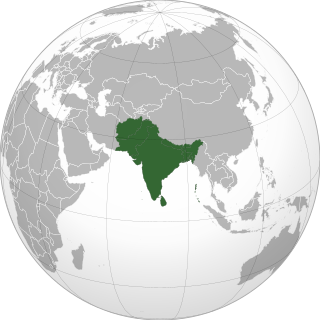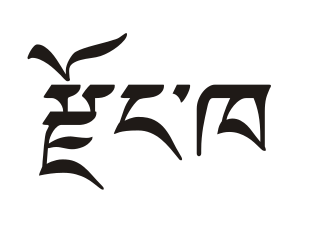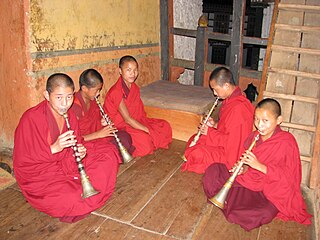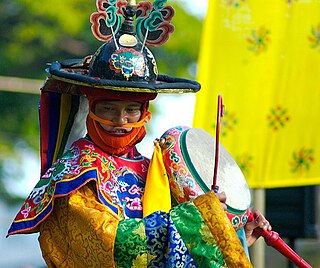
The Lhotshampa or Lhotsampa people are a heterogeneous Bhutanese people of Nepalese descent. "Lhotshampa", which means "southern borderlanders" in Dzongkha, began to be used by the Bhutanese state in the second half of the twentieth century to refer to the population of Nepali origin in the south of the country. After being displaced as a result of the state-run ethnic cleansing and living in refugee camps in eastern parts of Nepal, starting in 2007 most of the Bhutanese Refugees were resettled to various countries, such as the United States, Canada, Australia, the United Kingdom, and other European countries. As of 2021 the number of Lhotshampa in Nepal is significantly lower than that in the United States and other countries where they have resettled. People of Nepalese origin started to settle in uninhabited areas of southern Bhutan in the 19th century.

Bhutan's early history is steeped in mythology and remains obscure. Some of the structures provide evidence that the region has been settled as early as 2000 BC. According to a legend it was ruled by a Cooch-Behar king, Sangaldip, around the 7th century BC, but not much is known prior to the introduction of Tibetan Buddhism in the 9th century, when turmoil in Tibet forced many monks to flee to Bhutan. In the 12th century, the Drukpa Kagyupa school was established and remains the dominant form of Buddhism in Bhutan today. The country's political history is intimately tied to its religious history and relations among the various monastic schools and monasteries.

Cradled in the folds of the Himalayas, Bhutan has relied on its geographical isolation to protect itself from outside cultural influences. A sparsely populated country bordered by India to the south, and China to the north, Bhutan has long maintained a policy of strict isolationism, both culturally and economically, with the goal of preserving its cultural heritage and independence. Only in the last decades of the 20th century were foreigners allowed to visit the country, and only then in limited numbers. In this way, Bhutan has successfully preserved many aspects of its culture, which dates directly back to the mid-17th century.

Dzongkha is a Sino-Tibetan language that is the official and national language of Bhutan. It is written using the Tibetan script.

Kalimpong is a town and the headquarters of an eponymous district in the Indian state of West Bengal. It is located at an average elevation of 1,250 metres (4,101 ft). The town is the headquarters of the Kalimpong district. The region comes under Gorkhaland Territorial Administration which is an autonomous governing body within the state of West Bengal. The Indian Army's 27 Mountain Division is located on the outskirts of the city.

The music of Bhutan is an integral part of its culture and plays a leading role in transmitting social values. Traditional Bhutanese music includes a spectrum of subgenres, ranging from folk to religious song and music. Some genres of traditional Bhutanese music intertwine vocals, instrumentation, and theatre and dance, while others are mainly vocal or instrumental. The much older traditional genres are distinguished from modern popular music such as rigsar.
Kuensel is the national newspaper of the Kingdom of Bhutan. It was the only local newspaper available in Bhutan until 2006 when two more newspapers were launched. The government of Bhutan owns 51% of Kuensel while 49% is held by the public.

Bhutan, officially the Kingdom of Bhutan, is a landlocked South Asian country situated in the Eastern Himalayas, between China in the north and India in the south. A mountainous country, Bhutan is known locally as "Druk Yul" or "Land of the Thunder Dragon", a name reflecting the cultural heritage of the country. The exonym Bhutan likely derives from the Prakrit hybrid word Bhŏṭṭaṃta, a name referring to its geographical proximity to Tibet (Bhŏṭṭa). Nepal and Bangladesh are located near Bhutan but do not share a border with it. The country has a population of over 727,145 and a territory of 38,394 square kilometres (14,824 sq mi) and ranks 133rd in land area and 160th in population. Bhutan is a constitutional monarchy with a king as the head of state and a prime minister as the head of government. Vajrayana Buddhism is the state religion and the Je Khenpo is the head of the state religion.

The cham dance is a lively masked and costumed dance associated with some sects of Tibetan Buddhism and Buddhist festivals. The dance is accompanied by music played by monks using traditional Tibetan musical instruments. The dances often offer moral instruction relating to karuṇā (compassion) for sentient beings and are held to bring merit to all who perceive them.

The Newar language of Nepal has the fourth oldest literature tradition among the Sino-Tibetan languages.

Bhutanese refugees are Lhotshampas ("southerners"), a group of Nepali language-speaking Bhutanese people. These refugees registered in refugee camps in eastern Nepal during the 1990s as Bhutanese citizens who fled or were deported from Bhutan during the protest against the Bhutanese government by some of the Lhotshampas demanding human rights and democracy in Bhutan. As Nepal and Bhutan have yet to implement an agreement on repatriation, most Bhutanese refugees have since resettled to North America, Oceania and Europe under the auspices of the Office of the United Nations High Commissioner for Refugees. Many Lhotshampa also migrated to areas of West Bengal and Assam in India independently of the UNHCR.
Immigration to Bhutan has an extensive history and has become one of the country's most contentious social, political, and legal issues. Since the twentieth century, Bhutanese immigration and citizenship laws have been promulgated as acts of the royal government, often by decree of the Druk Gyalpo on advice of the rest of government. Immigration policy and procedure are implemented by the Lhengye Zhungtshog Ministry of Home and Cultural Affairs, Department of Immigration. Bhutan's first modern laws regarding immigration and citizenship were the Bhutanese Citizenship Act 1958 and subsequent amendments in 1977. The 1958 Act was superseded by the Bhutanese Citizenship Act 1985, which was then supplemented by a further Immigration Act in 2007. The Constitution of 2008 included some changes in Bhutan's immigration laws, policy, and procedure, however prior law not inconsistent with the 2008 Constitution remained intact. Bhutan's modern citizenship laws and policies reinforce the institution of the Bhutanese monarchy, require familiarity and adherence to Ngalop social norms, and reflect the social impact of the most recent immigrant groups.

Nepali literature refers to literature written in the Nepali language. The Nepali language has been the national language of Nepal since 1958.
Numerous ethnic groups inhabit Bhutan, but the Ngalop people who speak the Dzongkha language constitute a majority of the Bhutanese population. The Bhutanese are of four main ethnic groups, which themselves are not necessarily exclusive – the politically and culturally dominant Ngalop of western and northern Bhutan, the Sharchop of eastern Bhutan, the Lhotshampa concentrated in southern Bhutan, and Bhutanese tribal and aboriginal peoples living in villages scattered throughout Bhutan.

There are two dozen languages of Bhutan, all members of the Tibeto-Burman language family except for Nepali, which is an Indo-Aryan language, and Bhutanese Sign Language. Dzongkha, the national language, is the only native language of Bhutan with a literary tradition, though Lepcha and Nepali are literary languages in other countries. Other non-Bhutanese minority languages are also spoken along Bhutan's borders and among the primarily Nepali-speaking Lhotshampa community in South and East Bhutan. Chöke is the language of the traditional literature and learning of the Buddhist monastics.

Western-style education was introduced to Bhutan during the reign of Ugyen Wangchuck (1907–26). Until the 1950s, the only formal education available to Bhutanese students, except for private schools in Ha and Bumthang, was through Buddhist monasteries. In the 1950s, several private secular schools were established without government support, and several others were established in major district towns with government backing. By the late 1950s, there were twenty-nine government and thirty private primary schools, but only about 2,500 children were enrolled. Secondary education was available only in India. Eventually, the private schools were taken under government supervision to raise the quality of education provided. Although some primary schools in remote areas had to be closed because of low attendance, the most significant modern developments in education came during the period of the First Development Plan (1961–66), when some 108 schools were operating and 15,000 students were enrolled.
The national symbols of Bhutan include the national flag, national emblem, national anthem, and the mythical druk thunder featured in all three. Other distinctive symbols of Bhutan and its dominant Ngalop culture include Dzongkha, the national language; the Bhutanese monarchy; and the driglam namzha, a seventeenth-century code on dress, etiquette, and dzong architecture. Natural symbols of Bhutan are its national flower, the Himalayan blue poppy; its national tree, the Himalayan cypress; its national bird, the raven; and its national animal, the takin.
Bhutanese Nepali literature refers to the literary works in the Nepali language by Bhutanese people. This started from 1962 with the publishing of Kuensel.

The cinema of Bhutan is a small but emerging industry, having started in the mid-1990s. It has since been supported by government officials and different businesses.

Kalimpong district is a district in the state of West Bengal, India. In 2017, it was carved out as a separate district to become the 21st district of West Bengal.















